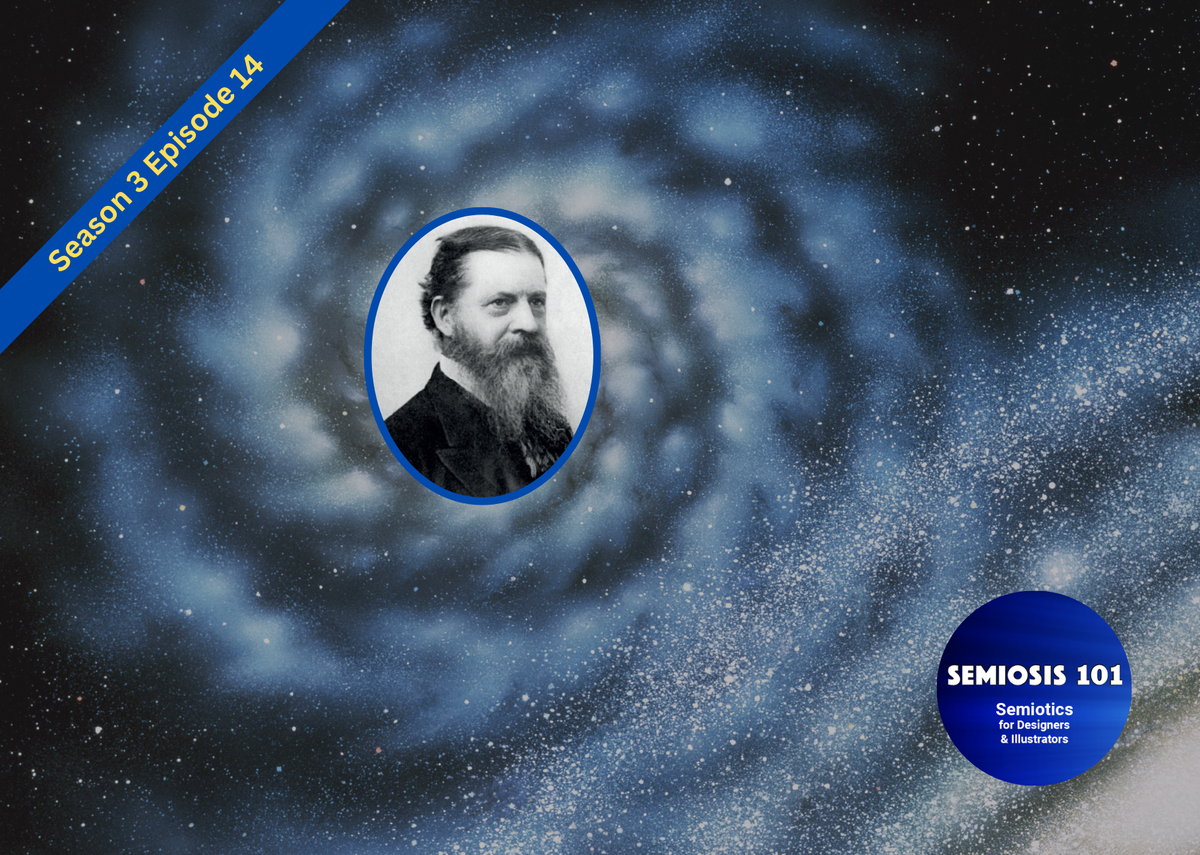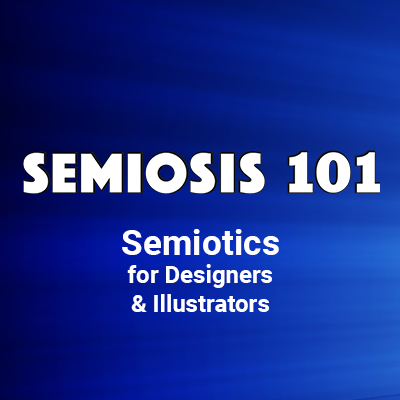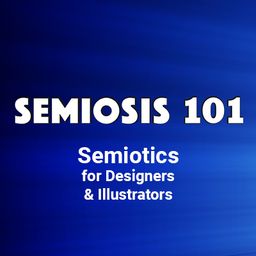Free Semiosis 101 Transcript 3.14:

INTERPRETATION AS DESIGN: Semiotic Signs Enhancing Visual Communication
Hello readers.
In this free transcript for the episode published on Semiosis 101 on Weds 7 February 2024, we will focus on semiotically enhancing aesthetic decisions to ensure your target audience can only interpret what you intend them to semiotically interpret.
Watch the free episode on YouTube for the full impact…
…and here is the episode’s transcript.
Over the last three episodes we have focused on audience interpretations. We looked at semiotic possibilities of meaning-bearing, probable sign-action and the semiotic framing of meaning. In this episode we will focus on enhancement. What I mean is semiotically enhancing aesthetic decisions to ensure the target audience can only interpret what you intend them to interpret. Let us go interpreting. Hit subscribe to this YouTube channel, and I will explain…
In the last episode I began to discuss Peirce’s other triadic relationships to how meaning is perceived and therefore interpreted. In the next episode we will begin to re-examine Peirce’s ten classifications of semiotic signs. The sign-action power of each of these ten signs, from simple to complex, is predicated on three triadic inter-relationships I have identified this season. We know Semiosis is predicated on the determination flow between the concept, its representation and then its interpretation. How the concept is represented is powered by Iconic, Indexical and Symbolic representation. How it is perceived and interpreted is powered as a Rheme, a Dicent or an Argument. (More on these next episode).
Semiosis’ final triad is the power of how the representation is delivered. We can call this a sign-vehicle. Back in episode 3.5 we examined the Qualisign. The Qualisign is the most basic delivery of the semiotic representation to the audience. A Qualisign is ephemeral. It is a quality and nothing more. Well not quite. It is a quality that can be weakly meaning-bearing. It is on the edge of perception, on the periphery of consciousness, which vanishes when perceived. What I mean is, contextually, a quality can semiotically kickstart communication of meaning through a perception it is familiar.
Quick caveat, we are discussing semiotic signs and not signage. Okay? Good, because I am about to reference signage here.
In danger signage, the colour red is often used as socio-culturally we identify red with danger. Red is red. In other contexts red can mean many other things. In danger signage, the application of red evokes a sense of danger. That is a Qualisign. The next two semiotic sign-vehicle levels are a Sinsign and Legisign. In episode 3.6 I promised to unpack these two terms, so here we are eight episodes later.
A Sinsign is the middle level of delivering the semiotic sign, and Legisign is the highest level. By examining the root in each level Quali, Sin, and Legi-sign we can see the perception levels. A Qualisign is in the perception state of Firstness, a state of possibilities, familiarities and resemblances. A Sinsign is in the perception state of Secondness, a state of probabilities, proposals and mediation. A Legisign is in the perception state of Thirdness, a state of generality, of agreements and interpretation. A Sinsign is a one-off delivery of meaning-bearing. A Legisign is more of a generally agreed delivery.
Sin as in single. Legi as in a law. Think on this. Quali as in quality. Sin as in single. Legi as in a law.
Those of you who are Semiosis 101 regulars will already be aware that semiotic signs are not tangible things but are encoded meaning-bearing. Therefore, in one moment a semiotic sign can be dormant and in the next active. A semiotic sign can be un-perceived and then perceived. In context (A) a blob can be perceived as an animal ear but in context (B) a blob can be a leg, or a plane, or a skyscraper, or anything. The quality of a blob may semiotically suggest an ear or a leg, but a blob is a blob. Its shape may change suggesting other qualities.
These Qualisign suggestions are weak and interpretations can be varied. A shape of an eye has a round quality. To visually communicate an eye, different shapes are used to suggest iris, cornea, pupil, reflections, etc. Different colour qualities are used to suggest eye variations, and composition of these shapes suggest where the eye is looking. These are just shapes (independent of whatever technique is used to visualise them). These shapes, in different configurations can visualise lots of other things too.
Can you see where I am going with this?
In one configuration, these various shapes define an eye. This is what Peirce defines a Sinsign. The individual shapes, that could also form many other things if configured differently, form a single element in an image, or as an image, or as a graphic, to visually communicate an eye. A sin-sign, a single sign-vehicle delivering the representation of the concept of an eye. A Sinsign which helps the interpreter to interpret “an eye.”
So if a Qualisign is a sign-vehicle which is an ephemeral semiotic meaning-bearing quality; and a Sinsign is a single-use sign-vehicle which is used to visually communicate a thing; then what is a Legisign?
Peirce is quite careful in how he defines a Legisign, “A Legisign is a law that is a sign. This law is usually established by [people]. Every conventional sign is a Legisign. It is not a single Object, but a general type which, it has been agreed, shall be significant” (CP 2.246). A “general type which, it has been agreed.”
Peircean scholar Professor Tony Jappy describes a Legisign as depending “largely upon personal experience of the world and ‘collateral,’ that is independent, knowledge of the [concept] determining the sign.” Consider what you all already know, and apply that to Legisigns.
What do I mean by that?
Peirce uses familiar terms such as LAW and Argument when trying to name what semiotically and perceptually happens at the point of interpretation. He is making a specific philosophical and logical point, but again, his terminology is nothing more than obtuse to the creative lay-person. We will look at this highest level of triadic sign-action in the same way we explored the lowest in episode 3.5.
The highest of Peirce’s ten semiotic sign classifications utilises Symbolic representation, an Argument, and IS a Legisign. We already know Symbolic representation employs visual generalities. We know an Argument in Peircean terms is nothing more than a general agreement. Can you see where I am going with this? A Legisign is a general expected way of experiencing the semiotic visual communication.
Eh?
Let me make you comfortable with this. What is a logo? Yes, yes, it represents a brand, an organisation, a business, etc. But what IS a logo? We all FEEL we know what a logo is. So when we see a single graphic mark, or a shape, initials, etc. we are happy to ASSUME it could be a logo. Every logo is different. They look different. But we still KNOW each one is a logo. Logos are meaning-bearing. They convey meaning through a “simple” visual identity. Logos deliver much more meaning, once recognised as such, that on its own it cannot visually bear.
Can you see where I am going with this? Apply that same thinking to Peirce’s Legisign.
Am I saying a logo IS a Legisign? Let us not get bogged down in analogy. As I stated in season two, episode 2.1… Semiotic Signs Are Not Signage - But Signage Uses Semiotics!
I am just trying to reset your perceptually thinking here. A Legisign is just a delivery method for the semiotic sign. If a quality is a weak and ephemeral meaning-bearing vehicle (Qualisign); and a single configuration of shapes, marks, etc. is a one-off meaning-bearing vehicle (Sinsign); then a Legisign is a generally accepted sign-vehicle that the target audience will expect. A logo is just one example of how Legisigns are experienced without thinking.
Also consider other things you do not notice such as wayfinding, or the app screen on your devices, or in the analogue world, the expectation of WHERE to open a packet. Everything you design or illustrate has visual communication embedded within it. The meaning-bearing visual elements should lead to the intended meaning, and not against it. The managing of perception is how Semiosis aids you creatives. In design we can describe what and how we design through a variety of different theoretical lenses.
This episode just helps you frame how semiotic sign-action can also benefit your successes through mindfully considering interpretation. We expanded on how semiotic representation can be delivered through three sign-vehicles of Qualisigns, Sinsigns and Legisigns. We will return to these next week when we will spend three episodes exploring in more detail, Peirce’s ten semiotic sign classifications. From simple to complex.
You will gain a clearer understanding how all of Peirce’s three triads of sign-action power interplay to enhance YOUR visual communication skills.
Semiosis 101 Semiotic Design Resources is a reader-supported publication. To receive exclusive posts and support my work, consider becoming a free or paid subscriber. Paid subscribers get name checked on all future Semiosis 101 YouTube episodes.
===Semiosis 101 Patreon Producer==============
Become a Semiosis 101 Patreon Producer and get a named producer credit on future video episodes, plus watch all new episodes months ahead of YouTube.
===Semiosis 101 Patreon Exclusives==============
Watch longer Patreon-exclusive Semiosis 101 episodes on applying Semiosis into design and illustration…
PATEXC001 How does semiotics work in illustration?





